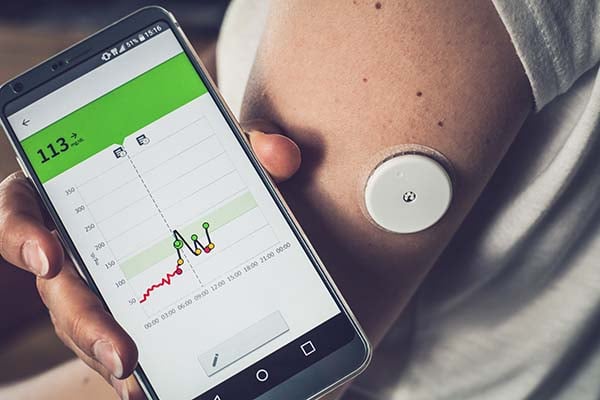By Laura Bollinger, RDN
Along with wearables and apps to track fitness, nutrition, and sleep, more advanced health technology is making its way into the consumer market as well. This technology is making it easier than ever to track and manage everything from colds to chronic diseases.
While staying healthy and preventing disease is an optimal goal, we all get sick now and then. In our third blog in the series, we’ll focus on managing your symptoms to recover faster with tech tools.
Flu & Fever
If fevers are so common in your house that you have trouble remembering who had a fever last, Withings Thermo may be a good addition to your medicine cabinet.
Thermo measures temperature then provides instant feedback letting you know if the temperature is elevated based on the age of the patient. It also sends the data to the app on your phone where you can see temperature trends, track symptoms, as well as medications to determine if treatment is working.
With its temporal sensor, it is a quick, non-invasive, and sanitary way to detect changes in temperature. It’s so easy, caretakers can even take their own temperature if needed! If a trip to the doctor is necessary, let your mind keep track of other things and simply send a complete history to your doctor with the associated app.

Blood Pressure Tracking
If blood pressure tracking is recommended by your doctor you may find it difficult to do regularly or remember your readings accurately. The FDA has recently approved Omron’s HeartGuide™, which is a blood pressure monitor in a watch. With the inflatable cuff integrated into the band, you can check your blood pressure anywhere you go!
The companion app for your smartphone allows you to track trends in your blood pressure. Possibly the most powerful aspect of this wearable is the ability to identify correlations between your blood pressure and lifestyle factors such as activity and sleep.
If on-the-go blood pressure monitoring is more than you need then Withings BPM Connect may suit your requirements better. This clinically validated wireless blood pressure monitor allows you to easily track blood pressure at home. With the smartphone app, you can then quickly share your results with your doctor.
The wireless cuff makes it easy to use at home and its small, sleek design makes it packable for those who travel frequently. The app also provides feedback on your readings based on recommendations from the American Heart Association. These recommendations and sharing readings with your doctor can lead to better blood pressure management, reducing the risk of complications related to high blood pressure.
Diabetes Management
Continuous glucose monitoring (CGM) systems used in conjunction with smart insulin pumps can be life-changing for insulin-dependent diabetic patients. Smart insulin pumps gather data from your CGM and automatically adjust insulin dosing to prevent blood glucose highs and lows.
Research shows that these systems can reduce low blood glucose events by as much as 72%. Additionally, these smart systems can send alerts to mobile apps if blood glucose drops dangerously low, making them truly lifesaving technology!

Wearable, needleless blood glucose monitoring devices are still a gadget of the future but companies are continuing to work to make it a reality. In the meantime, Medtronic has released an app, Guardian™ Connect, which syncs with their continuous glucose monitoring system to predict and prevent low blood glucose events for those requiring insulin injections.
iHealth® has developed a wireless glucose meter that connects with your phone to track blood glucose readings, allowing you to keep better track on the go, analyze trends, and share this information with your healthcare provider.
For those with diabetes, better blood glucose management can prevent short- and long-term complications of diabetes, including kidney disease or neuropathy.
If you’ve been diagnosed with IBS or Celiac Disease, there are apps for you too. FODMAP from Monash University is a valuable tool for those that find a FODMAP diet helpful. The Gluten Free Scanner can help identify foods containing gluten more easily.
Apps such as Sugar Sense and Glucose Buddy help track blood glucose levels and foods consumed, allowing for easy identification of glucose trends. Over time these apps can improve disease management by reducing symptoms. In addition, they can reduce the amount of time required to find foods that fit your particular dietary requirements.
Conclusion
Collecting a wide variety of health data points on ourselves and caring for our wellbeing has never been easier. As interest in personal health and wellness has increased so has the technology. From simple step trackers to Wi-Fi enabled blood pressure monitors, (not to mention the multitude of apps available for smartphones) if there is a wellness metric you want to track there is bound to be a device for it.
For even more motivation, accountability, and wellness success (if you are a Medi-Share member), connect your device with your health portal or contact one of our health coaches by logging into your Member Center!











Comments